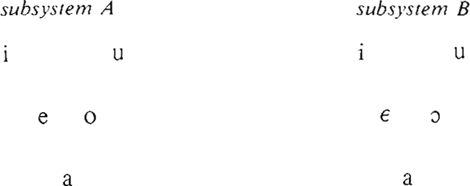The main purpose of this article is to demonstrate that Saramaccan, again uniquely among Creole languages, also possesses another feature typical of African (particularly West and Centra1 African) languages - vowel harmony. Although a number of publications have appeared recently which have directly or indirectly been concerned with Saramaccan phonology (Voorhoeve, 1959; Donicie and Voorhoeve, 1963; and particularly Rountree, 1972) the existence of this feature seems to have escaped notice. We will also show that this feature was once present in the neighbouring Sranan.
Although vowel harmony systems occur all over the world, they are particularly common in Africa and Northern Eurasia. They generally involve the vowel system being divided up into two subsystems such that in any particular morpheme or word only vowels belonging to one of the subsystems will occur.
In many cases the two subsystems are mutually exclusive - no vowel may belong to both subsystems. A case of this kind is seen in Nzima (Ladefoged, 1964) where we have the two subsystems:

Equally common, however, are systems where we get an overlap between the two subsystems. This is the case in Saramaccan where we get:

Here the units /i, u, a/ are common to both subsystems. This system is quite frequent in African languages, for instance W. African Yoruba and Idoma (Ladefoged, 1964) and the Congolese language Enya (Spa, 1973).
It is to be noted that the types of vowel harmony that we have just illustrated are typically African and differ from the Northern Eurasian types of vowel harmony, which typically involve subsystems of front versus back vowels and/ or rounded versus unrounded vowels. These African types of vowel harmony are known as cross-height vowel harmony and it would appear to be the case that Saramaccan presents the only example of such a system occurring outside Africa. Stewart (1971), referring to this type of vowel harmony, says that they are ‘apparently found nowhere outside Africa south of the Sahara’.
Thus in Saramaccan we may have on the one hand morphemes constructed out of the vowels /i, e, a, o, u/ or on the other hand morphemes constructed out of the vo-